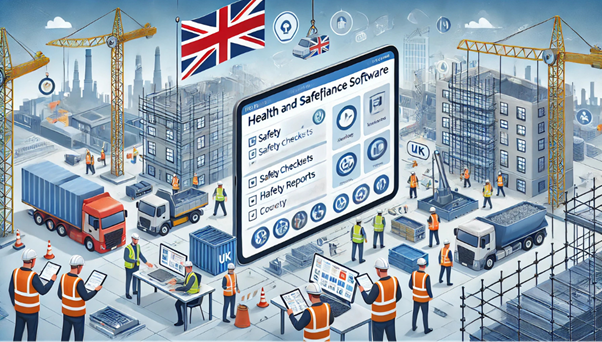Why Health and Safety Compliance Software is Vital in the UK Construction Industry

The construction industry in the UK plays a pivotal role in the economy, employing over 2.3 million people across the country. However, it is also one of the most hazardous sectors, with workers facing daily risks from dangerous machinery, falls from height, and exposure to hazardous materials. According to the Health and Safety Executive (HSE), in 2022/23, the construction industry recorded 45 fatal injuries and thousands of non-fatal injuries. These figures highlight the critical importance of maintaining rigorous health and safety standards across construction sites.
In light of the unique challenges and regulatory landscape in the UK, health and safety compliance software has become an indispensable tool for ensuring that construction companies meet their legal obligations, protect workers, and enhance operational efficiency. Here's why this technology is so vital for the UK construction industry.
1. Navigating UK Regulations and Standards
The UK has a stringent framework for health and safety in construction, primarily governed by laws such as the Health and Safety at Work Act 1974 and the Construction (Design and Management) Regulations 2015 (CDM Regulations). These regulations set out the responsibilities of employers, contractors, and workers to ensure that health and safety risks are managed effectively throughout the lifecycle of a construction project.
Compliance with these regulations is mandatory, and failure to do so can result in significant penalties. For example, the average fine for health and safety violations in the UK construction industry was £107,000 in 2022. Health and safety compliance software like MY Compliance Management, helps construction companies stay compliant by automatically updating them on any changes to regulations and ensuring that they can align all activities with the latest legal standards. This automation reduces the administrative burden and minimises the risk of costly fines or legal action.
2. Reducing Accidents and Fatalities
Despite advances in technology and safety practices, construction remains one of the most dangerous industries in the UK. The HSE reports that falls from height accounted for 24% of all fatal injuries in 2022/23, with other significant risks including being struck by moving vehicles or objects, and contact with electricity.
Health and safety compliance software enables construction firms to identify and mitigate these risks more effectively. The software can flag potential hazards, remind managers of scheduled safety inspections, and ensure that all workers have completed the necessary safety training. For example, before allowing a worker to operate machinery, the software can verify via a simple scan of a QR code that they have completed training in line with UK standards such as the Provision and Use of Work Equipment Regulations (PUWER).
By using software to track and address these risks in real-time, companies can significantly reduce the occurrence of accidents and fatalities, ensuring a safer working environment for all.
3.Boosting Efficiency and Reducing Costs
Health and safety compliance software not only enhances safety but also improves the efficiency of construction projects. In the UK, construction delays due to safety incidents can be incredibly costly. According to research, UK construction firms lose an estimated £800 million annually due to accidents, injuries, and subsequent project delays.
Compliance software helps reduce these delays by streamlining safety processes. Digital safety checklists, automated reminders for equipment maintenance, and real-time incident reporting mean that managers can focus on maintaining momentum on projects rather than manually tracking safety tasks. Furthermore, by reducing the number of accidents, companies can avoid the direct costs associated with medical treatment, compensation, and legal fees, as well as the indirect costs from project delays and lost productivity.
4. Enhancing Accountability and Transparency
The UK’s CDM Regulations emphasise the importance of communication and cooperation between all parties involved in a construction project, from designers to contractors to clients. Health and safety compliance software facilitates this by providing a centralised platform for documenting and sharing safety-related information.
This level of transparency ensures that everyone involved in a project understands their responsibilities and can be held accountable for safety performance. For example, the software can log and track safety training sessions, inspections, and incident reports, making it easy to identify gaps in compliance and assign corrective actions. In the event of an HSE inspection or audit, having all safety documentation readily available and properly organised can also help to demonstrate compliance and prevent potential fines or penalties.
5. Promoting Continuous Improvement in Safety Culture
Data from the HSE shows that although fatal injuries in construction have decreased significantly over the past 20 years, there is still much room for improvement, particularly in addressing non-fatal injuries and long-term health issues like respiratory diseases caused by exposure to asbestos or silica dust. Health and safety compliance software can play a key role in fostering a culture of continuous improvement in safety across UK construction sites.
By tracking incidents, near misses, and compliance data, the software allows construction companies to analyse trends and identify areas for improvement. Over time, this data-driven approach enables firms to refine their safety protocols, introduce better training programs, and implement more effective risk controls. For instance, the ease of reporting near misses using a simple link, mobile app or QR code within a compliance software tool means that these are more frequently reported instead of just waiting for an incident to happen. The trend analysis from these near misses can lead to improved risk assessments, training skills gaps and reduced incident rates.
This continuous improvement not only helps prevent future incidents but also demonstrates a commitment to worker safety, which can enhance a company's reputation and help attract talent in an industry where skilled labour is in high demand.
6. Ensuring Legal Compliance and Reducing Insurance Premiums
In the UK, construction companies are legally required to have adequate insurance coverage for their employees. However, frequent accidents and safety violations can lead to increased insurance premiums, which can be a significant financial burden for firms. Health and safety compliance software helps mitigate these risks by ensuring that all safety protocols are followed, incidents are logged and addressed promptly, and workers are properly trained.
By reducing the number of incidents and improving overall safety performance, companies can potentially lower their insurance premiums over time. Additionally, having robust health and safety processes in place can be a valuable asset when negotiating contracts with clients who are increasingly prioritising safety performance in their procurement decisions.
What does that mean for me?
In the UK construction industry, health and safety compliance is not just a legal requirement—it's a moral imperative and a business necessity. With thousands of workers facing life-threatening hazards every day, companies need to adopt the best tools available to protect their workforce, stay compliant with regulations, and improve operational efficiency.
Health and safety compliance software like MY Compliance Management offers a comprehensive solution to these challenges. By automating safety processes, tracking compliance, and providing real-time insights, this software helps construction companies minimise risks, reduce costs, and promote a culture of safety across all levels of the organisation.
As the UK continues to emphasise worker safety through rigorous regulations and enforcement, construction firms that leverage health and safety compliance software will be better positioned to thrive in an increasingly competitive and safety-conscious market. By prioritising worker well-being and embracing innovation, these companies can build a safer, more sustainable future for the UK construction industry.
What should I do now?
Register for a demonstration of MY Compliance Management now. One of our experienced team members can discuss the current issues you may be facing and map your requirements to our software so you can understand the cost savings and added risk protection you can get for just £159/month.
Exit

